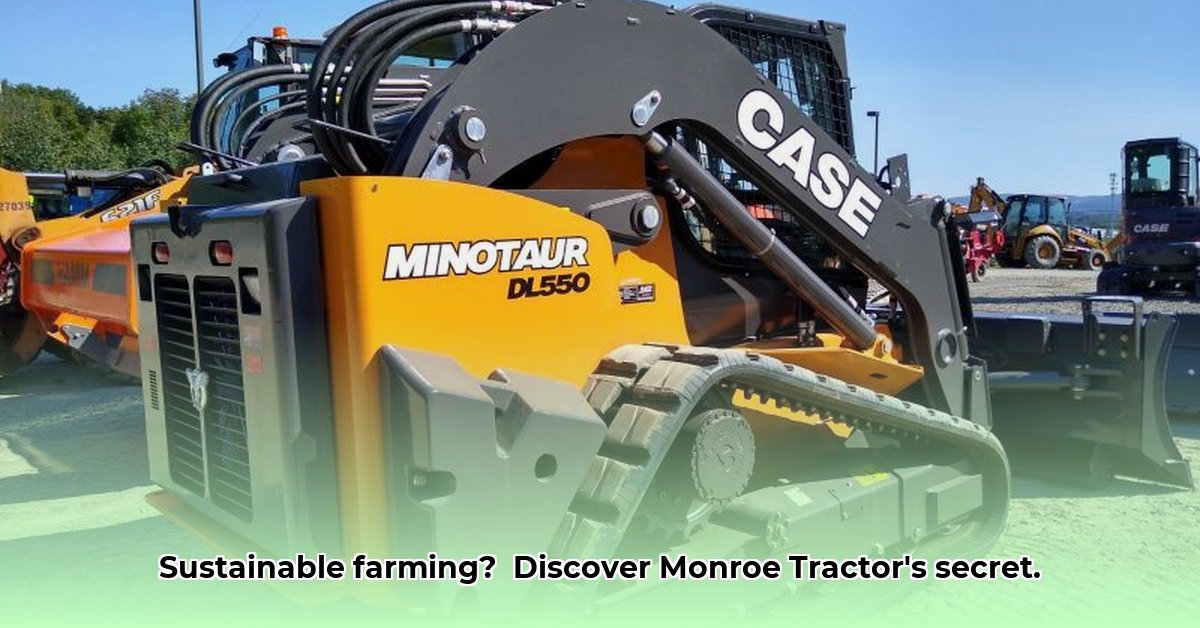
Navigating the Challenges of Sustainable Farming Equipment in Binghamton
Farming in the Binghamton, New York area presents unique challenges, particularly for those committed to sustainable agricultural practices. Securing reliable, appropriate equipment is often a major hurdle. This guide explores the complexities of equipment access and maintenance, focusing on the role of Monroe Tractor in Binghamton and offering practical strategies for farmers to navigate these difficulties. It’s a story not just about tractors, but about building a thriving, sustainable future for the region’s agriculture.
Imagine Sarah, a third-generation farmer near Binghamton, inheriting her family's land with a passion for sustainable agriculture. Her outdated tractor, however, struggles to keep pace with her ambitious goals. Replacing it feels daunting. The high cost of new equipment, coupled with the need for specialized tools suitable for sustainable farming methods, creates a significant barrier to entry for many, like Sarah. This isn't just an equipment problem; it's a systemic issue impacting the viability of sustainable farming itself. But how can we overcome these challenges?
Monroe Tractor Binghamton: A Vital Resource, but Not a Panacea
Monroe Tractor, with its extensive network of eighteen locations across the Northeast, is a significant presence in the agricultural equipment market. They offer a wide selection of new and used tractors, combines, and other machinery primarily from Case, Case IH, and CLAAS brands. This provides a solid foundation for many farmers. However, the question remains: Does Monroe Tractor completely address the specific needs of sustainable farming? Sustainable agriculture often necessitates specialized equipment, not always stocked by mainstream brands. This gap in access limits options for farmers seeking innovative, eco-friendly technologies. This raises a critical question: Are mainstream dealerships adequately supporting the unique demands of sustainable agriculture?
The New vs. Used Equipment Conundrum: Weighing Costs and Risks
The choice between new and used equipment is a crucial decision for any farmer. New equipment from Monroe Tractor, while expensive, often incorporates advanced technology improving efficiency and minimizing environmental impact. Features such as fuel-saving engines, precision planting systems, and advanced monitoring tools represent significant advantages. However, the high upfront cost can be prohibitive. Used equipment, on the other hand, offers a more affordable entry point or upgrade opportunity. But used equipment comes with its own set of risks. What strategies can mitigate the risks associated with purchasing used agricultural equipment? A thorough inspection, coupled with a realistic assessment of potential repair needs, is paramount.
The Critical Role of Maintenance and Parts Availability
Downtime during crucial periods like harvest can be devastating to a farm's profitability. Consequently, the availability of parts and the speed of service are critical. A robust parts inventory, and a responsive service network, are essential elements of a successful farming operation. How crucial is a rapid response time for equipment repair in maintaining farm profitability? Data suggests that even short delays can lead to significant losses. Monroe Tractor’s service network plays a vital role here, but does it consistently meet the expectations of farmers regarding parts availability and speedy repairs?
The Broader Ecosystem: Beyond the Dealership
The success of sustainable agriculture transcends the boundaries of a single dealership. It demands holistic support. Reliable transportation networks for timely parts delivery to rural areas are essential. Supportive government policies and incentives that make sustainable equipment financially accessible are also crucial. Furthermore, robust rural infrastructure, including reliable internet access for precision farming technologies, is a key component. To what extent does the broader infrastructure of a region influence the success of sustainable farming practices? The answer is paramount to the long-term viability of sustainable agriculture throughout regions like Binghamton.
Actionable Steps Towards a More Sustainable Future
This assessment highlights the need for collaborative action between farmers and equipment providers like Monroe Tractor to promote sustainable farming.
For Farmers:
- Thorough Needs Assessment: Carefully evaluate your specific equipment needs for your sustainable practices. Avoid unnecessary purchases.
- Diversified Options: Explore new and used equipment, weighing features, costs, and long-term implications. Consider leasing to ease financial burdens.
- Strategic Relationships: Forge strong relationships with local mechanics and parts suppliers.
- Advocacy: Support policies that invest in rural infrastructure and offer subsidies for sustainable equipment.
For Monroe Tractor Binghamton:
- Targeted Inventory: Expand parts inventory to include those specifically for sustainable farming equipment, even if less mainstream.
- Specialized Training: Ensure service technicians are well-versed in sustainable technologies and repair techniques.
- Extended Partnerships: Collaborate with smaller repair shops and suppliers to expand service coverage and access.
- Streamlined Technology: Develop efficient online systems for parts ordering, leveraging real-time tracking for improved communication.
Risk Assessment Matrix: Identifying and Mitigating Challenges
Sustainable farming inherently faces numerous risks. The following matrix summarizes key risk factors and potential mitigation strategies:
| Risk Category | Risk Description | Likelihood | Impact | Mitigation Strategies |
|---|---|---|---|---|
| Equipment Malfunction | Unexpected breakdowns; delayed repairs | Moderate | High | Preventative maintenance; readily available parts; skilled technicians |
| Financial Constraints | High initial equipment costs; limited access to credit | Moderate | High | Leasing options; government grants; used equipment purchases |
| Technological Change | Rapid advancements in tech; equipment obsolescence | Moderate | Medium | Flexible upgrade paths; equipment refurbishment; continuous learning |
| Geographic Limitations | Uneven access to services and supplies in rural areas | High | Medium | Improved rural infrastructure; mobile service units; strategic partnerships |
Conclusion: A Collaborative Path Forward
The future of sustainable agriculture in Binghamton necessitates a unified approach. Farmers, equipment dealers, and local governments must collaborate to create a supportive ecosystem. By addressing equipment access, maintenance, and broader infrastructure challenges proactively, we can cultivate a prosperous and environmentally responsible agricultural future for the region. Sarah’s success, and the success of countless other farmers, depends on this collective endeavor.